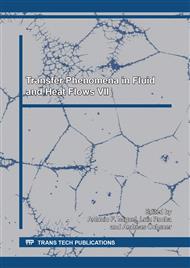[1]
Ju, B., T. Fan, and M. Ma, Enhanced oil recovery by flooding with hydrophilic nanoparticles. China Particuology, 2006. 4(1): pp.41-46.
DOI: 10.1016/s1672-2515(07)60232-2
Google Scholar
[2]
Li, R., et al., Experimental Investigation of Silica-Based Nanofluid Enhanced Oil Recovery: The Effect of Wettability Alteration. Energy & Fuels, 2016. 31(1): pp.188-197.
DOI: 10.1021/acs.energyfuels.6b02001
Google Scholar
[3]
Lee, J.W. and Y.T. Kang, CO 2 absorption enhancement by Al 2 O 3 nanoparticles in NaCl aqueous solution. Energy, 2013. 53: pp.206-211.
DOI: 10.1016/j.energy.2013.02.047
Google Scholar
[4]
Kim, W.-g., et al., Synthesis of silica nanofluid and application to CO2 absorption. Separation Science and Technology, 2008. 43(11-12): pp.3036-3055.
DOI: 10.1080/01496390802063804
Google Scholar
[5]
Busahmin, B., et al., Review on hole cleaning for horizontal wells. (2006).
Google Scholar
[6]
Busahmin, B., et al. Studies on the stability of the foamy oil in developing heavy oil reservoirs. in Defect and Diffusion Forum. 2016. Trans Tech Publ.
DOI: 10.4028/www.scientific.net/ddf.371.111
Google Scholar
[7]
McBride-Wright, M., G.C. Maitland, and J.M. Trusler, Viscosity and Density of Aqueous Solutions of Carbon Dioxide at Temperatures from (274 to 449) K and at Pressures up to 100 MPa. Journal of Chemical & Engineering Data, 2014. 60(1): pp.171-180.
DOI: 10.1021/je5009125
Google Scholar
[8]
Bagalkot, N. and A.A. Hamouda, Experimental and Numerical Method for Estimating Diffusion Coefficient of the Carbon Dioxide into Light Components. Industrial & Engineering Chemistry Research, 2017. 56(9): pp.2359-2374.
DOI: 10.1021/acs.iecr.6b04318
Google Scholar
[9]
Linstrom, P. and W. Mallard, NIST chemistry webbook, NIST standard reference database number 69, National Institute of Standards and Technology, Gaithersburg MD, 20899. (2010).
Google Scholar
[10]
Isdahl, O.M., Influence of Silica Based Nanofluid on the Physical Properties, IFT, and CO2 Diffusion in a Carbonated Water-n-decane system: An Experimental and Numerical Study. 2017, University of Stavanger, Norway.
Google Scholar
[11]
Haghtalab, A., M. Mohammadi, and Z. Fakhroueian, Absorption and solubility measurement of CO 2 in water-based ZnO and SiO 2 nanofluids. Fluid Phase Equilibria, 2015. 392:pp.33-42.
DOI: 10.1016/j.fluid.2015.02.012
Google Scholar
[12]
Zhu, H., B.H. Shanks, and T.J. Heindel, Enhancing CO− water mass transfer by functionalized MCM41 nanoparticles. Industrial & Engineering Chemistry Research, 2008. 47(20): pp.7881-7887.
DOI: 10.1021/ie800238w
Google Scholar
[13]
Shimadzu. The Structure of a Spectrophotometer 2017 [cited 2017 15.12]; Available from: https://www.shimadzu.com/an/uv/support/fundamentals/structure.html.
Google Scholar
[14]
Bagalkot, N., A.A. Hamouda, and O.M. Isdahl, Dynamic Interfacial Tension Measurement Method Using Axisymmetric Drop Shape Analysis. MethodsX, (2018).
DOI: 10.1016/j.mex.2018.06.012
Google Scholar
[15]
Herning, F. and L. Zipperer, Calculation of the viscosity of technical gas mixtures from the viscosity of individual gases. Gas u. Wasserfach, 1936. 79: p.69.
Google Scholar
[16]
Kandil, M.E., N.M. Al-Saifi, and A.S. Sultan, Simulation and measurements of volumetric and phase behavior of carbon dioxide+ higher alkanes at high pressure: CO2+ n-decane at temperatures (313–410) K and pressures up to 76 MPa. International Journal of Greenhouse Gas Control, 2016. 53: pp.198-206.
DOI: 10.1016/j.ijggc.2016.07.045
Google Scholar
[17]
Zambrano, J., et al., Volumetric behaviour of (carbon dioxide+ hydrocarbon) mixtures at high pressures. The Journal of Supercritical Fluids, 2016. 110: pp.103-109.
DOI: 10.1016/j.supflu.2016.01.002
Google Scholar
[18]
Yang, D. and Y. Gu, Determination of Diffusion Coefficients and Interface Mass-Transfer Coefficients of the Crude Oil− CO2 System by Analysis of the Dynamic and Equilibrium Interfacial Tensions. Industrial & Engineering Chemistry Research, 2008. 47(15): pp.5447-5455.
DOI: 10.1021/ie800053d
Google Scholar
[19]
Yang, D., P. Tontiwachwuthikul, and Y. Gu, Dynamic interfacial tension method for measuring gas diffusion coefficient and interface mass transfer coefficient in a liquid. Industrial & engineering chemistry research, 2006. 45(14): pp.4999-5008.
DOI: 10.1021/ie060047e
Google Scholar
[20]
Fathollahi, A. and B. Rostami, Carbonated water injection: Effects of silica nanoparticles and operating pressure. The Canadian Journal of Chemical Engineering, 2015. 93(11): pp.1949-1956.
DOI: 10.1002/cjce.22289
Google Scholar
[21]
Kang, Y.T., H.J. Kim, and K.I. Lee, Heat and mass transfer enhancement of binary nanofluids for H2O/LiBr falling film absorption process. International Journal of Refrigeration, 2008. 31(5): pp.850-856.
DOI: 10.1016/j.ijrefrig.2007.10.008
Google Scholar
[22]
Ashrafmansouri, S.-S. and M.N. Esfahany, Mass transfer in nanofluids: A review. International Journal of Thermal Sciences, 2014. 82: pp.84-99.
DOI: 10.1016/j.ijthermalsci.2014.03.017
Google Scholar
[23]
Krishnamurthy, S., et al., Enhanced mass transport in nanofluids. Nano letters, 2006. 6(3): pp.419-423.
Google Scholar
[24]
Fang, X., Y. Xuan, and Q. Li, Experimental investigation on enhanced mass transfer in nanofluids. Applied Physics Letters, 2009. 95(20): p.203108.
DOI: 10.1063/1.3263731
Google Scholar


